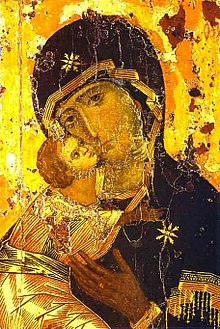| Revision as of 14:30, 13 September 2005 editGhirlandajo (talk | contribs)Autopatrolled, Extended confirmed users, Pending changes reviewers89,661 editsmNo edit summary← Previous edit | Revision as of 08:22, 20 September 2005 edit undo.:Ajvol:. (talk | contribs)2,400 editsm +ruNext edit → | ||
| Line 18: | Line 18: | ||
| ] | ] | ||
| ] | ] | ||
| ] | |||
Revision as of 08:22, 20 September 2005

The Theotokos of Vladimir, also known as the Virgin of Vladimir or Vladimirskaya, (Template:Lang-ru -- the Mother of God, of Vladimir) is one of the most venerated Orthodox icons. The Theotokos (Mary) is regarded as the holy protectress of Russia, and the icon is displayed in the Tretyakov Gallery, Moscow.
Patriarch Luke Chrysoberges of Constantinople sent the newly made icon as a gift to Grand Duke Yury Dolgoruky of Kiev about 1131. The beautiful image was coveted by Yury's son Andrei the Pious who brought it to his favourite city Vladimir in 1155. When the horses that transported the icon stopped near Vladimir and refused to go further, this was interpreted as a sign that the Theotokos wanted her icon to stay in Vladimir. To house the icon, the great Assumption Cathedral was built there, followed by other churches dedicated to the Virgin throughout northwestern Russia.
In 1395, during Tamerlane's invasion, the image was taken from Vladimir to the new capital, Moscow. The spot where people and the ruling prince met the icon is commemorated with the Sretensky monastery. Vasili I of Moscow spent a night crying over the icon, and Tamerlane's armies retreated the same day. The Muscovites refused to return the icon to Vladimir and placed it in the Cathedral of the Dormition of the Moscow Kremlin. The intercession of the Theotokos through the image was also credited with saving Moscow from Tatar hordes in 1451 and 1480.
One of the most exquisite icons ever created, the icon of the Theotokos of Vladimir is sometimes described as exhibiting universal feelings of motherly love and anxiety for her child. By the 16th century the Vladimirskaya (as the Russians call it) was a thing of legend. Church tradition asserted that the icon was painted by St Luke, though analysis of the image has disproved the legend. The venerated image was used in coronations of tsars, elections of patriarchs, and other important ceremonies of state. In December 1941, as the Germans approached Moscow, Stalin reputedly ordered that the icon be placed in an airplane and flown around the besieged capital. Several days later, the German army started to retreat.